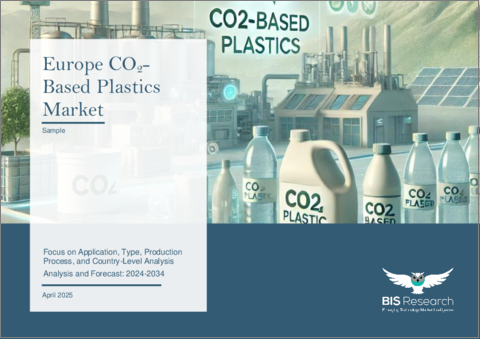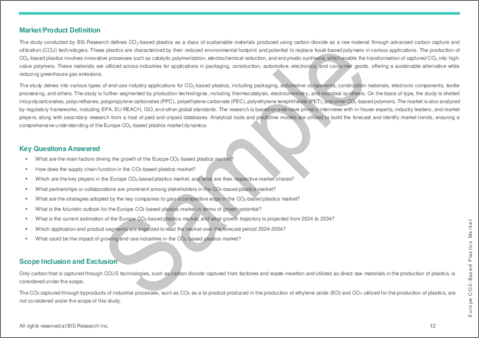|
|
市場調査レポート
商品コード
1707993
欧州のCO2ベースプラスチック市場:用途別、製品タイプ別、生産プロセス別、国別 - 分析と予測(2024年~2034年)Europe CO2-Based Plastics Market: Focus on Application, Type, Production Process, and Country-Level Analysis - Analysis and Forecast, 2024-2034 |
||||||
カスタマイズ可能
|
|||||||
| 欧州のCO2ベースプラスチック市場:用途別、製品タイプ別、生産プロセス別、国別 - 分析と予測(2024年~2034年) |
|
出版日: 2025年04月18日
発行: BIS Research
ページ情報: 英文 75 Pages
納期: 1~5営業日
|
全表示
- 概要
- 図表
- 目次
欧州のCO2ベースプラスチックの市場規模は、2024年の2億4,850万米ドルから2034年には61億8,750万米ドルに達し、予測期間の2024年~2034年のCAGRは37.92%となると予測されています。
二酸化炭素排出量の削減を目的とした強力な規制と、持続可能な材料調達への献身の高まりが、欧州市場力学に大きな影響を与えています。特にプラスチック産業では、厳しい環境規制と炭素回収・利用技術の迅速な開発の結果、生産プロセスが変化しています。こうした取り組みは、環境問題に取り組みながら技術革新を奨励する枠組みを確立する業界全体のパートナーシップによって、さらに強化されています。このような技術開発により、より環境に優しい生産技術への移行が可能となり、欧州企業は常に厳しい排出規制を満たすべく努力しています。この開発は、特にCO2ベースのプラスチック市場において顕著であり、環境的に有益な製品を求める消費者の需要の高まりが、継続的な進歩の原動力となっています。ここでは、市場のインセンティブと規制当局の圧力が相まって、環境への影響を軽減しつつ経営効率を向上させる持続可能な慣行への投資を促しています。その結果、欧州は最先端の低排出技術を生産工程に取り入れることに率先して取り組んでいます。この地域の創造的で倫理的な生産慣行への献身は、政策、技術、および業界の協力的な取り組みが相互に作用して新たな持続可能性基準を作り出そうとしていることで浮き彫りになっています。こうした傾向は、経済成長と環境保全の両立を目指す国際的な試みの先陣を切るものであり、循環型経済を目指す欧州の大きな推進力となっています。
| 主要市場統計 | |
|---|---|
| 予測期間 | 2024年~2034年 |
| 2024年の評価 | 2億4,850万米ドル |
| 2034年の予測 | 61億8,750万米ドル |
| CAGR | 37.92% |
欧州が低炭素・循環型経済を目指す中で、CO2ベースのポリマー市場の重要性が高まっています。環境への関心が高まり、欧州連合(EU)が厳しい気候変動規制を課す中、企業は化石燃料由来の従来のプラスチックに代わる持続可能な代替品を積極的に探しています。温室効果ガスを有用な材料に変えることで、CO2ベースのプラスチック(排出された炭素を集めて作られる)は、プラスチック汚染を緩和し、二酸化炭素削減目標を推進するための実行可能な方法を提供します。
CO2ベースのポリマーは、現在の産業インフラに適合し、環境への影響が小さいため、消費財、自動車、包装などの重要な産業でますます使用されるようになっています。炭素の回収と利用(CCU)技術は、生産効率とスケーラビリティを向上させ、これらの新しい材料の商業的実現可能性を高めています。さらに、欧州のグリーン・ディールやその他のグリーン技術への資金援助プログラムなど、強力な法的支援により、市場は今も拡大しています。
政府、学術機関、業界関係者は協力して技術革新を加速させ、CO2ベースのプラスチックの用途を広げています。製造コストの高さや顧客の認知度の低さなど、現在の障害にもかかわらず、継続的な投資と法的支援により、市場はより強く成長すると予想されます。CO2ベースのプラスチックは、欧州が気候変動に強いソリューションへの世界の移行を先導していることから、将来的には持続可能な材料の重要な構成要素になると予想されます。
欧州のCO2ベースポリマー市場は、多くの重要な要因により大きく拡大しています。炭素排出量削減を目的としたEUの厳格な法律により、産業界は従来のプラスチックに代わる持続可能な代替品を求めています。炭素の回収と利用における技術開発により、CO2を有用なポリマーに変換することが可能になり、これは循環型経済を目指す欧州の目標に沿ったものです。さらに、特に包装や自動車などの産業において、環境に優しい製品に対する顧客の需要が高まっているため、企業はCO2ベースのポリマーに投資しています。
しかし、市場には数多くのハードルがあります。普及の妨げとなっているのは、CO2ベースのプラスチックの生産コストが高いことです。これは、炭素回収技術が未熟であることと、特殊な設備が必要であることに起因しています。さらに、回収されたCO2とそれを使用するために必要なインフラが不足しているため、生産の拡張性が制限されています。産業拡大のさらなる障害には、より安価な従来のポリマーとの競合や、多額の研究開発費の必要性などがあります。
このセグメントでは、自動車、包装、建築、消費財など、産業界におけるCO2ベースのプラスチックの多様な用途を調査しています。熱触媒、光触媒、電気化学変換などの製造技術の進歩や、炭素回収、ポリマー合成の革新に焦点を当てています。また、ポリウレタン、ポリカーボネート、その他のCO2由来ポリマーなどの主要素材と、高度な触媒や自動化ツールなどの必須技術についても検証しています。ISOやASTMのような組織による規格への業界の準拠については、運用と規制の枠組みを包括的に理解するために議論されています。欧州のCO2ベースのプラスチック市場は、持続可能な材料への投資の増加、カーボンニュートラルの推進、拡張性と効率を高める技術革新に牽引され、急成長を遂げようとしています。その結果、この市場は持続可能性と収益性を重視した将来性の高いビジネスモデルとなります。
欧州のCO2ベースプラスチック市場は、既存参入企業にも新規参入者にも大きな機会を提供しています。主な成長戦略には、M&A、戦略的提携、新製品の発売、地理的拡大などがあります。企業は競争上の優位性を得るため、持続可能な素材と革新的な生産技術の開発を優先しています。カーボンフットプリントを削減し、世界の脱炭素化目標に沿うことに重点を置くことで、市場の拡大がさらに加速しています。
当レポートでは、ポリマーメーカー、技術プロバイダー、インテグレーターなど、欧州のCO2ベースプラスチック市場における主要参入企業を紹介しています。戦略的パートナーシップ、協定、技術協力を網羅した詳細な競合情勢分析は、利害関係者が未開拓の収益機会を特定するのに役立ちます。この分析は、市場参入企業が技術革新、戦略的提携、持続可能性への注力を通じて自社の地位を向上させることを支援します。
欧州のCO2ベースのプラスチック市場でプロファイルされている企業は、主要な専門家から収集したインプットと、企業のカバレッジ、製品ポートフォリオ、市場浸透度の分析に基づいて選定されています。
当レポートでは、欧州のCO2ベースプラスチック市場について調査し、市場の概要とともに、用途別、製品タイプ別、生産プロセス別、国別の動向、および市場に参入する企業のプロファイルなどを提供しています。
目次
エグゼクティブサマリー
第1章 市場
- 動向:現状と将来への影響評価
- サプライチェーンの概要
- 研究開発レビュー
- 規制状況
- ステークホルダー分析
- 主要な世界的出来事の影響分析
- 市場力学:概要
第2章 地域
- 地域サマリー
- 欧州
- 地域概要
- 市場成長促進要因
- 市場成長抑制要因
- 用途
- 製品
- 欧州(国別)
第3章 市場-競合ベンチマーキングと企業プロファイル
- 今後の見通し
- 地理的評価
- Covestro AG
- TotalEnergies Corbion
- Avantium
第4章 調査手法
List of Figures
- Figure 1: Europe CO2-Based Plastics Market (by Scenario), $Billion, 2024, 2028, and 2034
- Figure 2: CO2-Based Plastics Market (by Region), $Million, 2023, 2027, and 2034
- Figure 3: Europe CO2-Based Plastics Market (by Application), $Million, 2023, 2027, and 2034
- Figure 4: Europe CO2-Based Plastics Market (by Type), $Million, 2023, 2027, and 2034
- Figure 5: Europe CO2-Based Plastics Market (by Production Process), $Million, 2023, 2027, and 2034
- Figure 6: Competitive Landscape Snapshot
- Figure 7: Key Events
- Figure 8: Annual CO2 Emissions, Billion Tons, 2020-2023
- Figure 9: Global Percentage of Consumer Behavior toward Sustainability, 2022
- Figure 10: Supply Chain and Risks within the Supply Chain
- Figure 11: Value Chain Analysis
- Figure 12: Patent Analysis (by Country), January 2021-October 2024
- Figure 13: Patent Analysis (by Company), January 2020-December 2023
- Figure 14: COVID-19's Environmental Impact: Driving Demand for CO2-Based Plastics
- Figure 15: Impact Analysis of Market Navigating Factors, 2023-2034
- Figure 16: Global Production Capacities of Bio-Based Polymers per Region, 2023
- Figure 17: Share of Produced Biopolymers in Different Market Segments, 2023
- Figure 18: Projected Transition across Various Plastic Types in Europe, Million Tons, 2021-2050
- Figure 19: Germany CO2-Based Plastics Market, $Million, 2023-2034
- Figure 20: France CO2-Based Plastics Market, $Million, 2023-2034
- Figure 21: U.K. CO2-Based Plastics Market, $Million, 2023-2034
- Figure 22: Italy CO2-Based Plastics Market, $Million, 2023-2034
- Figure 23: Spain CO2-Based Plastics Market, $Million, 2023-2034
- Figure 24: Rest-of-Europe CO2-Based Plastics Market, $Million, 2023-2034
- Figure 25: Strategic Initiatives (by Company), 2020-2024
- Figure 26: Share of Strategic Initiatives, January 2021-November 2024
- Figure 27: Data Triangulation
- Figure 28: Top-Down and Bottom-Up Approach
- Figure 29: Assumptions and Limitations
List of Tables
- Table 1: Market Snapshot
- Table 2: Opportunities across Region
- Table 3: Trends Overview
- Table 4: CO2-Based Plastics Market Pricing Forecast (by Region), $/kg, 2023-2034
- Table 5: CO2-Based Plastics Market (by Region), $Million, 2023-2034
- Table 6: Europe CO2-Based Plastics Market (by Application), $Million, 2023-2034
- Table 7: Europe CO2-Based Plastics Market (by Type), $Million, 2023-2034
- Table 8: Europe CO2-Based Plastics Market (by Production Process), $Million, 2023-2034
- Table 9: Germany CO2-Based Plastics Market (by Application), $Million, 2023-2034
- Table 10: Germany CO2-Based Plastics Market (by Type), $Million, 2023-2034
- Table 11: Germany CO2-Based Plastics Market (by Production Process), $Million, 2023-2034
- Table 12: France CO2-Based Plastics Market (by Application), $Million, 2023-2034
- Table 13: France CO2-Based Plastics Market (by Type), $Million, 2023-2034
- Table 14: France CO2-Based Plastics Market (by Production Process), $Million, 2023-2034
- Table 15: U.K. CO2-Based Plastics Market (by Application), $Million, 2023-2034
- Table 16: U.K. CO2-Based Plastics Market (by Type), $Million, 2023-2034
- Table 17: U.K. CO2-Based Plastics Market (by Production Process), $Million, 2023-2034
- Table 18: Italy CO2-Based Plastics Market (by Application), $Million, 2023-2034
- Table 19: Italy CO2-Based Plastics Market (by Type), $Million, 2023-2034
- Table 20: Italy CO2-Based Plastics Market (by Production Process), $Million, 2023-2034
- Table 21: Spain CO2-Based Plastics Market (by Application), $Million, 2023-2034
- Table 22: Spain CO2-Based Plastics Market (by Type), $Million, 2023-2034
- Table 23: Spain CO2-Based Plastics Market (by Production Process), $Million, 2023-2034
- Table 24: Rest-of-Europe CO2-Based Plastics Market (by Application), $Million, 2023-2034
- Table 25: Rest-of-Europe CO2-Based Plastics Market (by Type), $Million, 2023-2034
- Table 26: Rest-of-Europe CO2-Based Plastics Market (by Production Process), $Million, 2023-2034
- Table 27: Market Share
Introduction to Europe CO2-Based Plastics Market
The Europe CO2-based plastics market is projected to reach $6,187.5 million by 2034 from $248.5 million in 2024, growing at a CAGR of 37.92% during the forecast period 2024-2034. Strong regulations aimed at reducing carbon emissions and a growing dedication to sustainable material sourcing have had a major impact on the dynamics of the European market. Production processes are changing, especially in the plastics industry, as a result of strict environmental regulations and quick developments in carbon capture and utilisation technologies. These initiatives are further strengthened by industry-wide partnerships, which establish a framework that encourages innovation while tackling environmental issues. These technical developments have made it possible for a move towards more environmentally friendly production techniques as European businesses constantly strive to meet ever-tougher emission requirements. This development is especially apparent in the market for CO2-based plastics, where ongoing advancement is driven by growing consumer demand for environmentally beneficial products. Here, market incentives and regulatory pressures combine to encourage investments in sustainable practices that improve operational efficiency while also lessening their environmental impact. As a result, Europe is taking the lead in incorporating cutting-edge, low-emission technologies into its production procedures. The region's dedication to creative, ethical production practices is being highlighted by the way that policy, technology, and cooperative industry efforts are interacting to create new sustainability standards. This tendency places the market at the vanguard of international attempts to achieve both economic growth and environmental stewardship, underscoring Europe's larger push towards a circular economy.
Market Introduction
| KEY MARKET STATISTICS | |
|---|---|
| Forecast Period | 2024 - 2034 |
| 2024 Evaluation | $248.5 Million |
| 2034 Forecast | $6,187.5 Million |
| CAGR | 37.92% |
As Europe moves towards a low-carbon, circular economy, the market for polymers based on CO2 is becoming increasingly important. Businesses are aggressively looking for sustainable substitutes for traditional plastics derived from fossil fuels as environmental concerns grow and the European Union imposes stringent climate rules. By turning greenhouse gases into useful materials, CO2-based plastics-which are made from collected carbon emissions-offer a viable way to alleviate plastic pollution and promote carbon reduction objectives.
CO2-based polymers are being used more and more in important industries like consumer products, automotive, and packaging because of their compatibility with current industrial infrastructure and smaller environmental impact. Carbon capture and utilisation (CCU) technology is improving production efficiency and scalability, increasing the commercial viability of these novel materials. Furthermore, the market is still expanding because to robust legislative assistance, such as the European Green Deal and other funding programs for green technologies.
Governments, academic institutions, and industry participants are working together to accelerate innovation and broaden the spectrum of applications for CO2-based plastics. The market is anticipated to grow stronger with continued investment and legislative assistance, notwithstanding present obstacles including high production costs and little customer awareness. Plastics based on CO2 are set to be a key component of sustainable materials in the future, as Europe spearheads the worldwide transition to climate-resilient solutions.
Market Segmentation:
Segmentation 1: by Application
- Packaging
- Films
- Bottles
- Containers
- Trays
- Automotive Components
- Interior Components
- Structural Parts
- Construction Materials
- Pipes
- Panels
- Insulation
- Electronics Components
- Casings
- Connectors
- Circuit Boards
- Textile Processing
- Fibers
- Non-Woven Fabrics
- Others
Segmentation 2: by Type
- Polycarbonates
- Polyurethanes
- Polypropylene Carbonate (PPC)
- Polyethylene Carbonate (PEC)
- Polyethylene Terephthalate (PET)
- Others
Segmentation 3: by Production Process
- Electrochemistry
- Microbial Synthesis
- Thermocatalysis
Segmentation 4: by Region
- Europe: Germany, U.K., France, Spain, Italy, and Rest-of-Europe
Market trends, drivers and challenges of Europe CO2-Based Plastics Market
The market for CO2-based polymers in Europe is expanding significantly due to a number of important factors. Industries are looking for sustainable substitutes for conventional plastics as a result of strict EU laws designed to lower carbon emissions. Technological developments in carbon capture and utilisation have made it possible to convert CO2 into useful polymers, which is in line with Europe's goals for a circular economy. Additionally, businesses are investing in CO2-based polymers because to the growing customer demand for eco-friendly products, especially in industries like packaging and automotive.
However, the market faces numerous hurdles. Widespread adoption is hampered by the high production costs of CO2-based plastics, which are caused by the infancy of carbon capture technology and the requirement for specialised equipment. Production scalability is further limited by the scarcity of captured CO2 and the infrastructure needed to use it. Further impediments to industry expansion include competition from less expensive, traditional polymers and the requirement for large R&D expenditures.
How This Report Can Add Value to End Users
Product/Innovation Strategy: This segment explores the diverse applications of CO2-based plastics across industries, including automotive, packaging, construction, and consumer goods. It highlights advancements in production techniques such as thermocatalysis, photocatalysis, and electrochemical conversion, as well as carbon capture and polymer synthesis innovations. The report also examines key materials such as polyurethanes, polycarbonates, and other CO2-derived polymers alongside essential technologies such as advanced catalysts and automation tools. Industry compliance with standards from organizations such as ISO and ASTM are discussed to provide a comprehensive understanding of operational and regulatory frameworks. The Europe CO2-based plastics market is set for rapid growth, driven by increasing investments in sustainable materials, the push for carbon neutrality, and technological innovations that enhance scalability and efficiency. Consequently, this market represents a high-potential business model emphasizing sustainability and profitability.
Growth/Marketing Strategy: The Europe CO2-based plastics market offers substantial opportunities for established players and new entrants. Key growth strategies include mergers and acquisitions, strategic collaborations, new product launches, and geographic expansion. Companies have been prioritizing the development of sustainable materials and innovative production technologies to gain a competitive advantage. The focus on reducing carbon footprints and aligning with global decarbonization goals has been further accelerating market expansion.
Competitive Strategy: The report profiles major players in the Europe CO2-based plastics market, including polymer manufacturers, technology providers, and integrators. A detailed competitive landscape analysis covering strategic partnerships, agreements, and technological collaborations is provided to help stakeholders identify untapped revenue opportunities. This analysis supports market participants in enhancing their position through innovation, strategic alliances, and a focus on sustainability.
Key Market Players and Competition Synopsis
The companies that are profiled in the Europe CO2-based plastics market have been selected based on inputs gathered from primary experts and analyzing company coverage, product portfolio, and market penetration.
Some of the prominent names in the market are:
- Covestro AG
- TotalEnergies Corbion
- Avantium
Table of Contents
Executive Summary
Scope and Definition
1 Markets
- 1.1 Trends: Current and Future Impact Assessment
- 1.1.1 Increasing Focus toward Carbon Capture and Utilization (CCU)
- 1.1.2 Growing Consumer Demand for Eco-Friendly Products
- 1.2 Supply Chain Overview
- 1.2.1 Value Chain Analysis
- 1.2.2 Pricing Forecast
- 1.3 Research and Development Review
- 1.3.1 Patent Filing Trend (by Country and Company)
- 1.4 Regulatory Landscape
- 1.5 Stakeholder Analysis
- 1.5.1 End User and Buying Criteria
- 1.6 Impact Analysis for Key Global Events
- 1.6.1 COVID-19
- 1.6.2 Russia/Ukraine War
- 1.7 Market Dynamics: Overview
- 1.7.1 Market Drivers
- 1.7.1.1 Advancements in Bio-Based Polymers
- 1.7.1.2 Accelerating the Shift toward Renewable Carbon Sources
- 1.7.2 Market Restraints
- 1.7.2.1 Competition and Synergies with Bioplastics
- 1.7.2.2 Fossil-Fuel Plastic Price Fluctuations
- 1.7.3 Market Opportunities
- 1.7.3.1 Customizable Properties for Niche Applications
- 1.7.3.2 Biodegradable Applications of CO2-Based Plastics in Medical Devices and Packaging
- 1.7.1 Market Drivers
2 Regions
- 2.1 Regional Summary
- 2.2 Europe
- 2.2.1 Regional Overview
- 2.2.2 Driving Factors for Market Growth
- 2.2.3 Factors Challenging the Market
- 2.2.4 Application
- 2.2.5 Product
- 2.2.6 Europe (by Country)
- 2.2.6.1 Germany
- 2.2.6.2 France
- 2.2.6.3 U.K.
- 2.2.6.4 Italy
- 2.2.6.5 Spain
- 2.2.6.6 Rest-of-Europe
3 Markets - Competitive Benchmarking & Company Profiles
- 3.1 Next Frontiers
- 3.2 Geographic Assessment
- 3.2.1 Covestro AG
- 3.2.1.1 Overview
- 3.2.1.2 Top Products/Product Portfolio
- 3.2.1.3 Top Competitors
- 3.2.1.4 Target Customers/End Users
- 3.2.1.5 Key Personnel
- 3.2.1.6 Analyst View
- 3.2.1.7 Market Share, 2023
- 3.2.2 TotalEnergies Corbion
- 3.2.2.1 Overview
- 3.2.2.2 Top Products/Product Portfolio
- 3.2.2.3 Top Competitors
- 3.2.2.4 Target Customers/End Users
- 3.2.2.5 Key Personnel
- 3.2.2.6 Analyst View
- 3.2.2.7 Market Share, 2023
- 3.2.3 Avantium
- 3.2.3.1 Overview
- 3.2.3.2 Top Products/Product Portfolio
- 3.2.3.3 Top Competitors
- 3.2.3.4 Target Customers/End Users
- 3.2.3.5 Key Personnel
- 3.2.3.6 Analyst View
- 3.2.3.7 Market Share, 2023
- 3.2.1 Covestro AG
4 Research Methodology
- 4.1 Data Sources
- 4.1.1 Primary Data Sources
- 4.1.2 Secondary Data Sources
- 4.1.3 Data Triangulation
- 4.2 Market Estimation and Forecast






